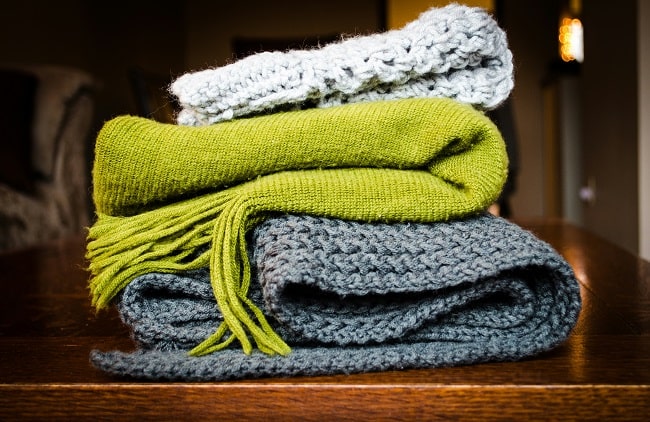As temperatures dip and winter arrives, keeping warm without relying too heavily on heating can help reduce your energy bills and environmental impact. Fortunately, there are many natural ways to stay warm, ranging from strategic layering techniques to cozy home solutions. These methods help keep you comfortable indoors and out, providing efficient warmth while saving on costs. Let’s explore how to stay warm naturally, embracing techniques that are both practical and sustainable.
The Benefits of Staying Warm Naturally
Choosing natural ways to keep warm offers multiple advantages:
- Energy Savings: Relying less on central heating helps save on utility bills.
- Sustainability: Reducing energy consumption is kinder to the environment.
- Comfort and Flexibility: Layering and cozy solutions allow you to adjust your warmth according to your needs, helping you stay comfortable.
With these benefits in mind, let’s dive into effective layering techniques and cozy ideas for winter warmth.
Layering Techniques for Optimal Warmth
Layering is a time-tested way to insulate yourself against the cold, especially when you’re spending time outside or in a cooler indoor environment. Effective layering helps trap body heat and keeps you warm without the bulk. Here’s how to layer effectively:
Start with the Base Layer: Moisture-Wicking Materials
Your base layer is closest to your skin, so it’s essential to choose a material that wicks away moisture. When you sweat, it can make you feel cold, but moisture-wicking fabrics keep your skin dry, which is essential for warmth.
Best Base Layer Materials:
- Merino Wool: Naturally insulating and moisture-wicking, merino wool is soft, breathable, and odor-resistant, making it ideal for winter.
- Synthetic Fabrics (like polyester): Lightweight and affordable, synthetics wick moisture effectively, though they may lack the natural warmth of wool.
- Silk: Lightweight, warm, and moisture-wicking, silk makes a good base layer in moderately cold weather but might not provide enough insulation in extreme cold.
Tip: Avoid cotton as a base layer, as it retains moisture and can leave you feeling cold.
Add Insulation with the Middle Layer
The middle layer serves as insulation, trapping heat generated by your body. This layer should be slightly looser than the base layer to create air pockets that hold warmth.
Best Middle Layer Options:
- Fleece Jackets or Pullovers: Fleece is lightweight, breathable, and provides excellent insulation without bulk.
- Down Vests or Jackets: For extremely cold conditions, down offers superior warmth and insulation.
- Thicker Wool Sweaters: Wool is naturally insulating and breathable, perfect for retaining body heat in cold weather.
Tip: A thicker fleece or down vest can work well in milder winter weather, while adding a full down jacket or wool sweater provides more warmth in colder conditions.
Finish with the Outer Layer: Windproof and Waterproof
The outer layer protects against wind, rain, and snow, essential for preventing heat loss. Choose a jacket or coat that blocks wind and repels moisture, keeping your other layers dry and warm.
Best Outer Layer Choices:
- Windproof Jackets: Lightweight yet effective, these jackets provide wind protection without adding bulk.
- Waterproof Parkas: In wet or snowy weather, waterproof parkas keep you dry and insulated.
- Softshell Jackets: Softshell jackets provide some wind resistance and flexibility, making them great for mild winter days.
Tip: Look for jackets with adjustable hoods, cuffs, and waistbands to lock in warmth and prevent drafts.
Essential Accessories for Warmth
In addition to layering clothing, don’t forget to add key accessories to keep extremities warm.
Warm Accessories:
- Hats: A lot of body heat is lost through the head, so a beanie or wool cap is essential.
- Gloves or Mittens: Mittens keep your hands warmer than gloves, as they trap heat by keeping fingers together.
- Scarves: A thick scarf keeps your neck warm and can also be wrapped around your face in extremely cold weather.
- Thermal Socks: Wool or thermal socks keep feet cozy and insulated, especially when paired with winter boots.
Tip: Avoid wearing tight socks or shoes, as restricted circulation can make your feet feel colder.
Cozy Solutions to Stay Warm Indoors Naturally
Indoor warmth is just as important, especially when you’re trying to reduce heating costs. Here are simple, natural solutions for keeping cozy indoors.
Use Layers of Blankets and Throws
Layering blankets on your couch or bed allows you to adjust warmth based on your comfort level. Thicker blankets made of materials like wool, fleece, or flannel are great for trapping heat.
Tip: Keep a cozy throw or blanket in your favorite seating area to stay warm without having to adjust the thermostat.
Warm-Up with Hot Beverages
A cup of tea, coffee, or hot chocolate can provide an instant warmth boost. Holding a warm mug is comforting, and sipping a hot beverage helps raise your core temperature.
Tip: Opt for herbal teas in the evening to stay warm without the caffeine, which can affect sleep.
Make Use of Sunlight
Natural sunlight is an excellent heat source during winter. Keep curtains or blinds open during the day to let sunlight in, which can naturally warm your space.
Tip: Close curtains after sunset to trap the heat gained during the day and keep the cold out.
Use Area Rugs to Insulate Floors
Bare floors can be chilly in winter, so adding area rugs in living spaces, bedrooms, and hallways can help insulate against cold floors. Thick, plush rugs also add warmth and comfort to your home’s décor.
Tip: If possible, opt for wool rugs, which are naturally insulating and keep floors warmer.
Seal Windows and Doors
Drafts from windows and doors are a major source of heat loss in winter. Use draft stoppers, weatherstripping, and insulated curtains to keep warm air inside.
Tip: For a budget-friendly draft stopper, use a rolled-up towel or blanket at the base of doors and windows.
Wear Indoor Layers
When it’s chilly indoors, layering isn’t just for outside. Wear lightweight base layers like thermal tops and leggings under your clothes, along with cozy socks and sweaters, to stay warm without needing to turn up the heat.
Tip: Look for loungewear made of fleece or wool for an extra layer of insulation while you relax at home.
Extra Cozy Solutions for Warmth
Sometimes, a little extra coziness is all you need to stay comfortable. Try these additional solutions to keep warm naturally:
Use a Hot Water Bottle or Heating Pad
A hot water bottle or heating pad can warm up your bed or seating area quickly. Place it at the foot of your bed to keep your feet warm while you sleep.
Tip: For a DIY solution, fill a sock with uncooked rice and microwave it for a minute for a homemade heating pad.
Close Off Unused Rooms
If you have rooms that aren’t in use, close their doors to contain heat in commonly used spaces. This simple trick helps maintain warmth in frequently used areas, making your heating efforts more efficient.
Cook at Home and Enjoy the Warmth
Cooking at home not only provides delicious, warming meals but also naturally heats your kitchen. Baking or slow cooking throughout the day adds warmth and creates a cozy aroma that fills your home.
Tip: After baking, leave the oven door open to let residual heat warm the kitchen (be sure it’s safe to do so and keep children and pets at a distance).
Frequently Asked Questions
How many layers should I wear to stay warm outside?
Typically, three layers—a base, an insulating middle layer, and an outer layer—are ideal for cold weather. Adjust layers based on temperature and activity level.
What materials are best for staying warm?
Wool, fleece, and down are excellent insulating materials. Merino wool, in particular, is highly recommended for its warmth and moisture-wicking properties.
Can I stay warm indoors without turning on the heat?
Yes, you can use natural techniques like layering clothes, using blankets, sealing drafts, and drinking hot beverages to stay warm indoors without relying on heating.
How does layering keep you warm?
Layering traps warm air between each layer, creating insulation that keeps you warmer than a single bulky layer would.
What are some quick ways to warm up naturally?
Drink a hot beverage, put on a hat, use a hot water bottle, or bundle up with an extra blanket for quick, natural warmth.
Conclusion
Staying warm naturally is all about making the most of simple, effective techniques that allow you to feel cozy and comfortable. By using strategic layering when dressing and making small adjustments at home, you can significantly reduce your reliance on heating while staying warm throughout winter. Embrace these natural ways to stay warm and enjoy a season of comfort, coziness, and savings.

